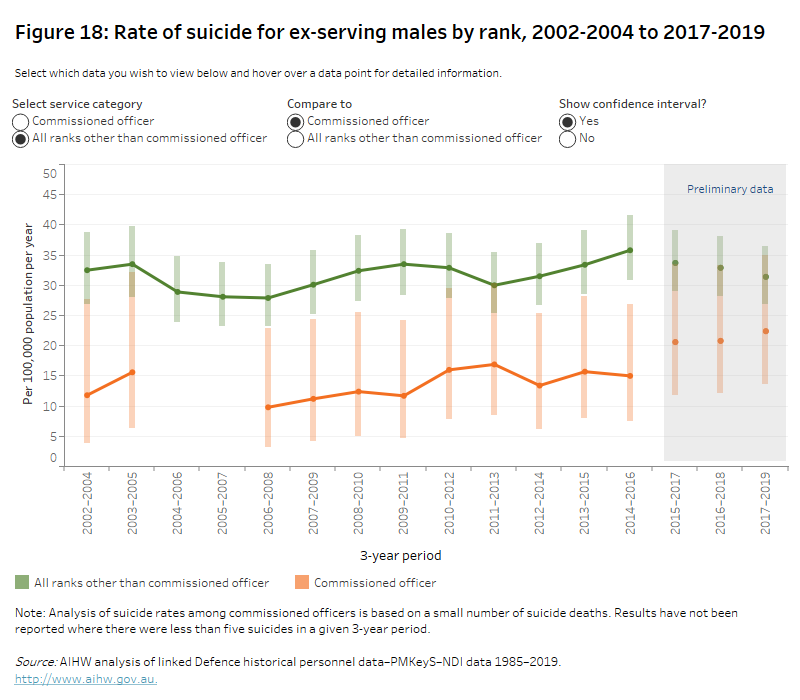Suicides by rank
Rank describes organisational and workforce structures that determine a member’s position, conditions, opportunities and entitlements (such as pay and conditions). The analysis here is based on rank at time of separation. It is presented in two broad groups: commissioned officers and all ranks other than commissioned officer.
Around 86% of ex-serving males and ex-serving females were in the group “all other ranks” at time of separation. About 1 in 5 (22.5%) males who separated voluntarily were commissioned officers and around 77% of males who voluntarily separated were in the group all other ranks.
|
Rank at time of separation |
Ex-serving males: |
Ex-serving females: |
|---|---|---|
|
Commissioned officer(a) |
15.1 |
11.8 |
|
All ranks other than commissioned officer(b) |
31.8 |
15.4 |
Notes
- An appointed Defence member who holds a rank of Midshipman or Officer Cadet, or higher.
- A Defence member who holds a Sailor, Other Ranks or Airman/Airwoman rank.
Source: AIHW analysis of linked Defence historical personnel data–NDI data 1985–2019.
Between 2002 and 2019, the suicide rates for ex-serving males who were commissioned officers at the time of separation was half that of those who were all other ranks (15.1 compared with 31.8 per 100,000 population per year).
For ex-serving females, rates of suicide were similar for both commissioned officers and all other ranks.
Figure 17: Suicide rate by rank, ex-serving males and females, 2002–2019
Source: AIHW analysis of linked Defence historical personnel data-PMKeyS–NDI data 1985–2019.
Suicide rate by rank over time
Rates of suicide for ex-serving males, who separated as all ranks other than commissioned officer, show no variation over time.
Analysis of suicide rates among commissioned officers is based on a small number of suicide deaths. Results have not been reported where there were less than five suicides in the 3-year periods, 2004 to 2006 and 2005 to 2007.
Due to small number of suicide deaths among ex-serving females, suicide rates by rank over time are not reported.
The interactive graph below presents the suicide rates for ex-serving males in each of the rank groups, for all 3-year periods from 2002-2004 to 2017-2019.

Note: The confidence intervals in this figure can be used to determine the significance of differences between the suicide rates calculated for the ex-serving within a given 3-year period. However, they cannot be used to determine the significance of differences between rates calculated for the ex-serving population for overlapping 3-year time periods (for example 2002–2004 and 2003–2005).
Data underlying this graph are available in Supplementary table S6.4. See Data for a link to the tables.
Please note, data for more recent years are subject to change; see Technical notes for further detail.
If you need help or support, please contact:
Open Arms - Veterans and Families Counselling 1800 011 046
Open Arms Suicide Intervention page
Defence All-hours Support Line (ASL) 1800 628 036
Defence Member and Family Helpline 1800 624 608
Defence Chaplaincy Support 1300 333 362
Lifeline 13 11 14
Suicide Call Back Service 1300 659 467
Beyond Blue Support Service 1300 22 4636
For information on support provided by DVA, see:
References
AIHW 2018. Incidence of suicide in serving and ex-serving Australian Defence Force personnel: detailed analysis 2001-2015. Cat. No. PHE 218. Canberra; AIHW.
AIHW 2020. National suicide monitoring of serving and ex-serving Australian Defence Force personnel: 2020 update. Cat. No. PHE 277. Canberra; AIHW.


